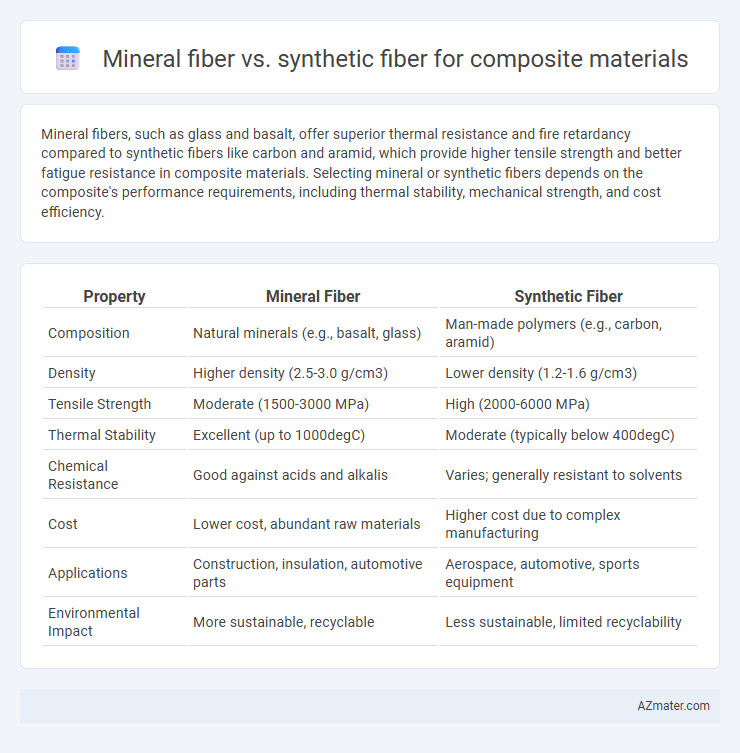Mineral fibers, such as glass and basalt, offer superior thermal resistance and fire retardancy compared to synthetic fibers like carbon and aramid, which provide higher tensile strength and better fatigue resistance in composite materials. Selecting mineral or synthetic fibers depends on the composite's performance requirements, including thermal stability, mechanical strength, and cost efficiency.
Table of Comparison
| Property | Mineral Fiber | Synthetic Fiber |
|---|---|---|
| Composition | Natural minerals (e.g., basalt, glass) | Man-made polymers (e.g., carbon, aramid) |
| Density | Higher density (2.5-3.0 g/cm3) | Lower density (1.2-1.6 g/cm3) |
| Tensile Strength | Moderate (1500-3000 MPa) | High (2000-6000 MPa) |
| Thermal Stability | Excellent (up to 1000degC) | Moderate (typically below 400degC) |
| Chemical Resistance | Good against acids and alkalis | Varies; generally resistant to solvents |
| Cost | Lower cost, abundant raw materials | Higher cost due to complex manufacturing |
| Applications | Construction, insulation, automotive parts | Aerospace, automotive, sports equipment |
| Environmental Impact | More sustainable, recyclable | Less sustainable, limited recyclability |
Introduction to Composite Materials
Mineral fibers, such as basalt and glass fibers, offer high temperature resistance, excellent mechanical strength, and chemical stability, making them ideal for reinforcing composite materials used in aerospace and construction. Synthetic fibers, like carbon and aramid fibers, provide superior tensile strength, lightweight properties, and enhanced fatigue resistance, widely utilized in automotive and sports equipment composites. The selection between mineral and synthetic fibers in composite materials depends on specific performance requirements, cost considerations, and environmental factors influencing durability and application scope.
Overview of Mineral Fibers
Mineral fibers, such as basalt and glass fibers, exhibit high thermal stability, excellent chemical resistance, and significant mechanical strength, making them ideal for composite material reinforcement in extreme environments. These inorganic fibers enhance fire resistance and durability while maintaining low density, which contributes to improved structural performance without considerable weight increase. Compared to synthetic fibers, mineral fibers offer better resistance to heat and chemical exposure, providing longer service life in demanding applications like aerospace, automotive, and construction composites.
Overview of Synthetic Fibers
Synthetic fibers in composite materials offer high tensile strength, excellent durability, and resistance to chemical and environmental degradation, making them ideal for demanding engineering applications. Common synthetic fibers such as carbon, glass, and aramid fibers provide improved mechanical performance and lighter weight compared to mineral fibers. These fibers enable enhanced structural integrity and tailored properties in composites for aerospace, automotive, and construction industries.
Mechanical Properties Comparison
Mineral fibers, such as basalt and glass fibers, exhibit superior tensile strength and thermal stability compared to synthetic fibers like polyester and nylon, making them ideal for high-performance composite materials. Synthetic fibers generally offer higher impact resistance and better fatigue endurance, contributing to lightweight and flexible composite structures. The mechanical property differences influence the selection of fibers based on specific application requirements like load-bearing capacity, durability, and environmental resistance.
Thermal Stability and Resistance
Mineral fibers, such as basalt and glass fibers, exhibit superior thermal stability and resistance, maintaining structural integrity at temperatures exceeding 1000degC, making them ideal for high-temperature composite applications. Synthetic fibers like aramid and carbon fibers offer moderate thermal resistance but tend to degrade or lose strength at temperatures above 500degC to 600degC. The choice between mineral and synthetic fibers in composites depends heavily on the required thermal performance, with mineral fibers favored for extreme heat resistance.
Durability and Longevity Analysis
Mineral fibers, such as basalt and glass fibers, offer superior durability and long-term stability due to their high resistance to heat, chemical corrosion, and UV radiation, making them ideal for composite materials exposed to harsh environments. Synthetic fibers like aramid and polyethylene provide excellent impact resistance and flexibility but tend to degrade faster under prolonged UV exposure and chemical attack, which can limit their longevity in outdoor applications. Performance data indicates mineral fiber-reinforced composites maintain structural integrity over extended periods, outperforming synthetic counterparts in durability and lifespan in demanding industrial uses.
Environmental Impact and Sustainability
Mineral fibers, such as glass and basalt, generally have a lower environmental impact compared to synthetic fibers like carbon or aramid due to their natural origin and recyclability. Mineral fibers contribute to sustainability by being produced from abundant raw materials and enabling easier reuse or recycling processes in composite materials. Synthetic fibers often rely on petroleum-based inputs and involve energy-intensive manufacturing, leading to higher carbon footprints and challenges in end-of-life disposal.
Cost and Availability Considerations
Mineral fibers typically offer a cost advantage due to abundant natural sources like basalt and asbestos, making them widely available and economically feasible for large-scale composite production. Synthetic fibers, such as glass or carbon fibers, involve higher manufacturing costs and energy consumption, resulting in higher prices but more consistent quality and performance. Availability of synthetic fibers depends on industrial production capacity, whereas mineral fibers rely on natural deposits, which can be regionally limited but offer stable raw material supply.
Applications in Industry Sectors
Mineral fibers, such as basalt and glass fibers, are widely used in the automotive, aerospace, and construction industries due to their excellent heat resistance, mechanical strength, and electrical insulation properties. Synthetic fibers like carbon and aramid fibers dominate sectors requiring high strength-to-weight ratios and impact resistance, including high-performance sports equipment, military armor, and advanced aerospace components. Both fiber types enhance composite materials' durability and performance, with mineral fibers preferred for thermal insulation and synthetic fibers favored for structural reinforcement.
Conclusion: Choosing the Right Fiber for Composites
Mineral fibers offer superior high-temperature resistance and enhanced mechanical strength, making them ideal for structural composites in extreme environments. Synthetic fibers provide greater flexibility, lighter weight, and improved impact resistance, suitable for applications demanding durability and weight reduction. Selecting the right fiber depends on the specific performance requirements, environmental conditions, and cost constraints of the composite material application.

Infographic: Mineral fiber vs Synthetic fiber for Composite material
 azmater.com
azmater.com